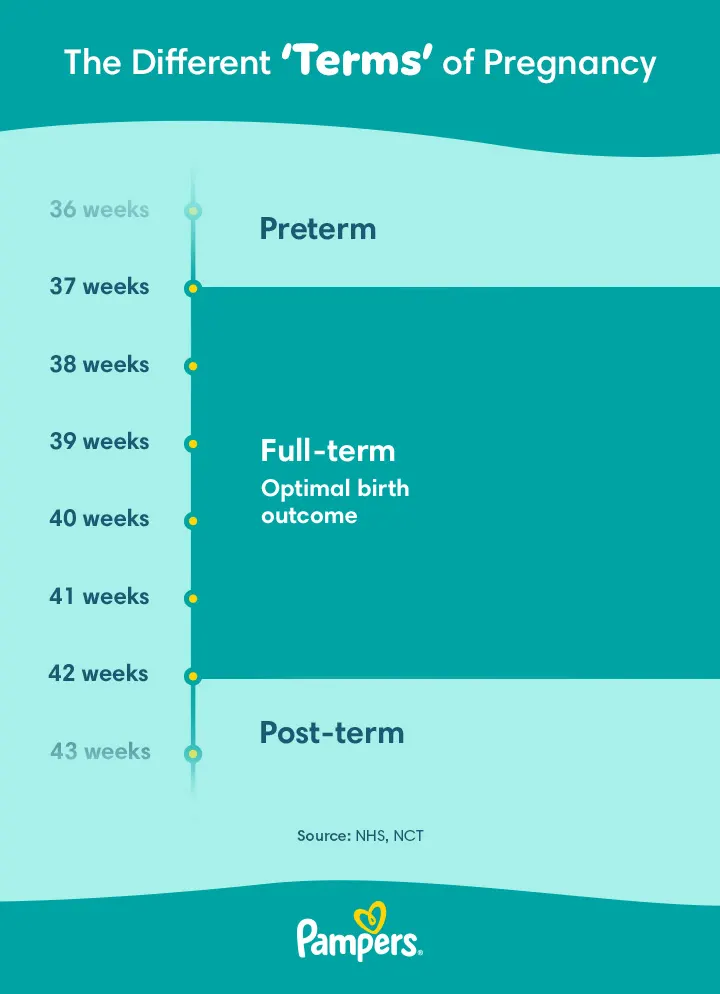
All About Full-Term Pregnancy
As you near the end of your pregnancy, you’re likely eagerly awaiting your due date and the arrival of your new baby. Keep in mind that your due date is just an estimate and most babies are born a week or two on either side of this date. So, what is considered a full-term pregnancy, and what happens if your baby is born earlier or later than expected? Our article covers the pregnancy terms ‘preterm’, ‘full-term’ and ‘post-term’ and the associated weeks, plus some things to consider if your baby is overdue.
How Many Weeks Is a Full-Term Pregnancy?
Your pregnancy is generally considered full-term between 37 weeks and 42 weeks. If your baby is born between these weeks, they’re considered to be full-term or term.
Your pregnancy due date is generally estimated at 40 weeks; however, this is just an estimate and it’s common for babies to be any time between 37 and 42 weeks.
RELATED PREGNANCY TOOL
What Do Preterm, Full-Term and Post-term Mean?
According to the NHS, the final weeks of pregnancy are as follows:
If you’re unsure of what week you’re currently in, you can ask your GP or midwife for more clarification. It can be a little tricky to remember which week of pregnancy is which but this image should help make it a little easier:
What Is Considered a Full-Term Pregnancy with Twins?
It’s common for twins and triplets to be born prematurely (before 37 weeks). If you’re pregnant with twins, your doctor and midwife will discuss the best time for you to give birth and the best methods of delivery based on your circumstances and the type of multiple pregnancy.
It’s likely your doctor will suggest a planned birth date for you and your babies. The following is common for twins, triplets and higher multiples:
This is, of course, just an average, and your doctor will discuss your options based on your individual circumstances.
Is 37 Weeks Full Term?
Yes, 37 weeks pregnant is considered full-term. At this stage, the baby has likely grown and developed enough to survive outside the womb without major complications. However, for many babies, there may still be a few weeks left until they make their big appearance. This is because a full-term pregnancy can run from 37 weeks to 42 weeks. And as we mentioned above, if you’re pregnant with twins, they’ll likely arrive around 37 weeks, as it’s unlikely for twin pregnancies to go beyond 38 weeks.
What Are The Risks of an Overdue Pregnancy?
It’s normal for your baby to arrive a little earlier or later than your due date. Your due date is, after all, only an estimate of when your pregnancy will have lasted 40 weeks. Once you’ve reached your due date, there are still two more weeks to go before your pregnancy is considered post-term or overdue. This is why your doctor may recommend being patient for a few more days or weeks if your due date comes and goes with no sign that your little one is ready to make an appearance.
When considering the best course of action for your situation, there are a few risks your doctor will assess. For example, late or post-term delivery may increase the risk of
To check that everything is OK with your little one, your doctor or midwife may perform special tests to measure your baby’s heart rate or an ultrasound to check your baby’s growth, movements and the amount of amniotic fluid around your baby. If everything is looking good, your doctor may recommend a membrane sweep which may help start labour, or they may suggest delaying induction for a couple more days or weeks.
When Might Labour Be Induced?
If your due date has come and gone, in some cases your doctor and midwife might recommend that labour be induced. This step might be taken to reduce the risk of possible complications, such as your baby being significantly bigger at birth or there being lower amounts of amniotic fluid. Keep in mind, labour can sometimes be induced earlier in pregnancy, too. Induction is sometimes considered during the full- or preterm stage if you have health complications like gestational diabetes or high blood pressure; if there are problems with the placenta like placental abruption (when the placenta separates from the uterus); or if your baby shows signs of poor growth.
You’ll have a lot on your mind toward the end of your pregnancy, so remember that your doctor and midwife are on top of this and will give you all the information you need before any decisions are made about inducing labour. You’re in good hands!
Can You Reduce the Chances of Post-Term Pregnancy?
There’s no surefire way to prevent a late- or post-term pregnancy. However, you may be more likely to go past your due date if
In some cases, to keep your pregnancy from progressing to the late- or post-term stage, your doctor may recommend something called a membrane sweep. In this procedure, your midwife or doctor will ‘sweep’ a gloved finger along the membranes that connect the amniotic sac to your uterine wall. This can sometimes help to release hormones and soften the cervix to kick-start labour. If you just can’t wait to give birth, you may be starting to wonder about the effectiveness of some old wives’ tales like spicy food being used to begin labour. Keep in mind that there’s not enough medical evidence to support the safety and effectiveness of certain foods or herbal supplements, so if you’re considering alternative ways to jump-start labour, check with your doctor first.
Is an Elective Delivery an Option?
In consultation with their doctor and midwife, some pregnant people end up having an elective/scheduled caesarean section delivery or an induction. There are some nonmedical reasons an elective delivery could be considered, including living in a rural area far away from the hospital; reducing end-of-pregnancy discomfort, or easing childbirth anxiety or fear. Suppose you’re interested in an elective caesarean delivery. In that case, your doctor will discuss the benefits and risks for you and your baby, as well as offer you support if you’re feeling anxious about childbirth.
FAQS AT A GLANCE
The optimal time for delivery is usually around 39 to 40 weeks. This timing allows the baby to fully mature while minimising potential complications associated with earlier or later deliveries. However, full-term is considered to be between 37 and 42 weeks – so it’s generally good to give birth during this period.
The Bottom Line
It might feel as if you’ve been waiting forever to meet your baby, but your little one will be here before you know it. Make sure you’re aware of those telltale signs of labour and how to time your contractions so you’ll know when it’s time to call your doctor or midwife.
While you wait for the big day, don’t forget to download the Pampers Club App to start earning rewards and discounts on all those nappies you’ll need.
How We Wrote This Article The information in this article is based on expert advice found in trusted medical and government sources, such as the National Health Service (NHS). You can find a full list of sources used for this article below. The content on this page should not replace professional medical advice. Always consult medical professionals for full diagnosis and treatment.
- NCT. Overdue Baby – What Happens If My Baby is Late?
- NHS. Antenatal Care With Twins
- NHS. Caesarean Section
- NHS. Inducing Labour
- NHS. Induction of Labour Post Dates (overdue) Pregnancy
- NHS. Premature Labour and Birth
- NHS. Twins and Multiple Pregnancies
- NHS. Week 37
- NHS. What Happens If Your Baby is Measuring Large for Dates?
- NHS. 42 Weeks
Read more about Pregnancy
Related Articles
Join Pampers Club and get















